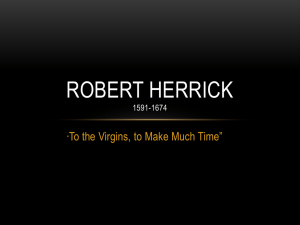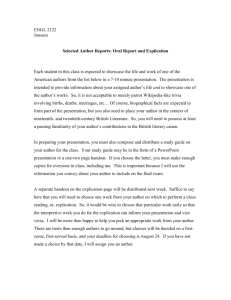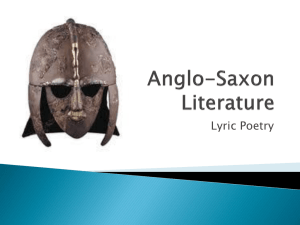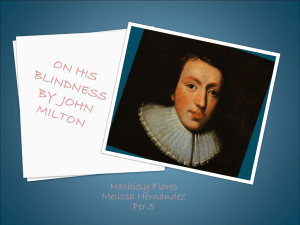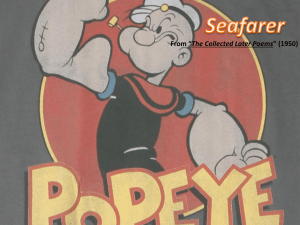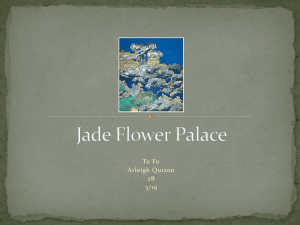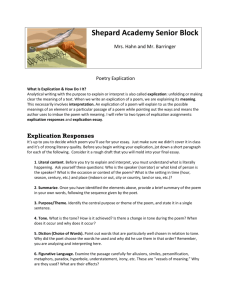Poetry Analysis
advertisement
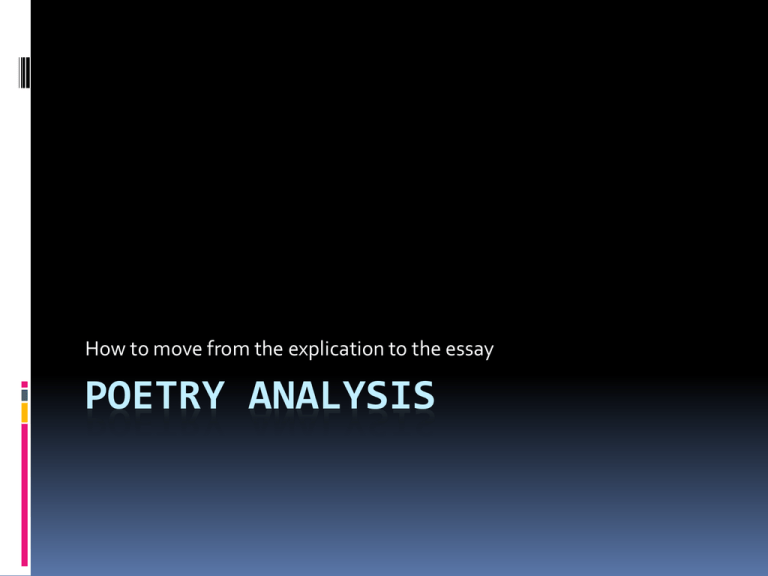
How to move from the explication to the essay POETRY ANALYSIS Opening Paragraph The first paragraph The first paragraph should present the large issues; it should inform the reader which conflicts are dramatized and should describe the dramatic situation of the speaker. The explication does not require a formal introductory paragraph; the writer should simply start explicating immediately. A good way to begin: “The poem “to the Virgins, to Make Much of Time” by Robert Herrick, dramatizes the conflict between …” Such a beginning ensures that you will introduce the major conflict or theme in the poem and organize your explication accordingly. Body The next paragraphs The next paragraphs should expand the discussion of the conflict by focusing on details of form, rhetoric, syntax, and vocabulary. In these paragraphs, the writer should explain the poem line by line in terms of these details, and he or she should incorporate important elements of rhyme, rhythm, and meter during this discussion. Conclusion The conclusion?? The explication has no formal concluding paragraph; do not simply restate the main points of the introduction! The end of the explication should focus on sound effects or visual patterns as the final element of asserting an explanation. Example Herrick’s sixteenth century poem“To the Virgins to Make Much of Time” dramatizes the conflict between committing to marriage and the swift passage of time. The speaker in the poem, a young man, uses an urgent tone and images of passing time to encourage the woman to be aware that time will not wait for her and her commitment needs to be made soon. He reminds her that her youth will pass as quickly as wilting flowers, the passage of a day, and a race being run. She will lose the warmth of youth as time always wins. He finally reminds her that being “coy” will allow her youth to disappear and she will always be waiting for what will never be. Through the use of metaphors, personification, rhyme, and the arrangement of stanzas, Herrick conveys his theme of carpe diem. Paragraph 2 The first stanza of the poem emphasized the ideas of quickly passing time through the metaphor of the flowers. Herrick begins his poem with an imperative sentence, “Gather ye rosebuds while ye may/ Old Time is still a fly’n” (1,2). The flowers being fresh or young is reinforced by the word “smiling,” and the reminder that tomorrow “they will be dying” indicates that time will not stop. “Old Time” is personified as the upper case indicates . Referring to Time as “Old” gives a sharp contrast to the swiftness but relentlessness of youth. The rhyme scheme abab emphasizes the words “a-flying” and “be dying,” and illustrates the contrast between the two. The regular meter gives a the poem a quick pace, mirroring the fast passage of time. Paragraph 3 Moving from the reminder of time moving fast, the next stanza begins a series of metaphors that further illustrate the idea that time waits for no one. “The glorious lamp of heaven, the sun”/the higher he’s a getting,” gives the image of a passing day (5,6). By using the words “glorious” to describe the sun appeals to the sense of sight, and the speaker continues the metaphor of the sun meshed with the image a the “race be run” with the setting sun in the next line: “The sooner will his race be run,/ and nearer he’s to setting” (7,8). The sense of finality is evident here, and the continuing rhyme pattern and meter that is consistent with the first moves the poem in the same unstopping manner. The use of the words “higher” and “nearer” give the sense that time is gaining on the young girl, and the rhyme continues to quicken the pace, just as time is quickly passing. Tips to remember Refer to the speaking voice in the poem as the speaker” or “the poet.” For example, do not write, “In this poem, Wordsworth says that London is beautiful in the morning.” However, you can write, “In this poem, Wordsworth presents a speaker who…” We cannot absolutely identify Wordsworth with the speaker of the poem, so it is more accurate to talk about “the speaker” or “the poet” in an explication. Use the present tense when writing the explication. The poem, as a work of literature, continues to exist! To avoid unnecessary uses of the verb “to be” in your compositions, the following list suggests some verbs you can use when writing the explication: Punctuation Use a slant between two lines of poetry Punctuate line citations after the quotes and before the period, but retain the poet’s capitalization and punctuation. “Gather ye rosebuds while ye may,/Old Time is still a-flying;” (1,2). Verbs to use dramatizes presents illustrates characterizes underlines asserts posits enacts connects portrays contrasts juxtaposes suggests implies shows addresses emphasizes stresses accentuates
